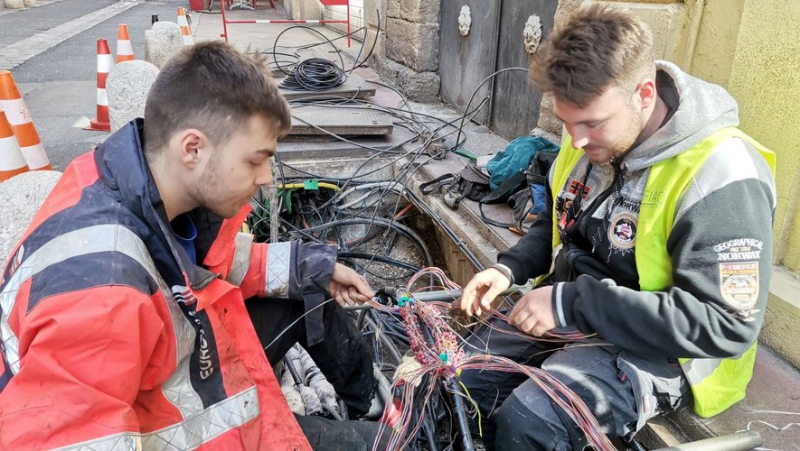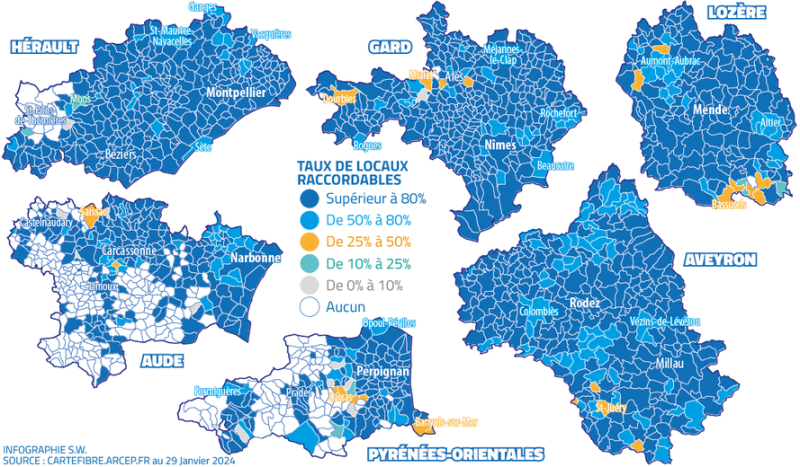Deployment of optical fiber: the final stretch towards a very high-speed Languedoc

Thousands of kilometers of optical fiber are deployed across the region. G.I.
The State had set the objective of deploying optical fiber across the entire territory by 2025, in order to avoid any digital divide. However, it is in rural areas that the work is more advanced. We take stock in the region.
It was February 20, 2013. President Hollande announced the mobilization of 20 billion euros to develop access to very high speed for all. Eight years later, Prime Minister Jean Castex completed the ambition of general optical fiber coverage by 2025 to "reduce digital divides". The health crisis was there, causing a boom in teleworking, particularly in rural areas.
Twelve years to provide a minimum of 100 megabits/second everywhere in France, that may seem like an eternity, "it’is, however, a technological tidal wave if we compare it to the time previously necessary to generalize the copper network (telephony) or electricity", says Nicolas Brochot, Occitanie regional director of the operator Orange. An industrial performance which will be all the more remarkable if deadlines are met. Currently, the fiber optic coverage rate is 84% in France, slightly more in Occitanie.
"A phase of lace"
When it's time to enter the final straight, Nicolas Brochot warns all the same, "this one will be long… and maybe not so straight. If all operators have progressed very well so far, we will now have to look for pockets of complexity, everything that has been left aside to allow this industrial volume effect. We are entering the lace phase".
This may seem paradoxical, but it is particularly in the most urbanized sectors that the greatest effort remains to be made. An example: in Hérault, while the area located in the hinterland has a coverage rate of 94%, "with 250,000 homes and businesses already connectable for a target of 268,000", counts the vice-president of the Department Claudine Vassas-Mejri, this figure is only 84% in Montpellier.

The deployment rate by department according to figures from Arcep, end of January 2024. Sophie Wauquier
The difficulty of entering buildings
"That’explains", reassures the regional delegate from Orange. "First of all, the mayor is very careful about heritage issues and if we discuss very well together, this extends the deadlines. Above all, unlike individual homes, to bring fiber into a building, you have to intervene inside the building, therefore obtaining the agreement of the trustee, which is not always easy. .And in Montpellier, there are very many buildings.
A "colossal"construction site
The countryside also has its difficulties to overcome. "The area we had to fiber required three times more civil engineering and 17 times more aerial. There was complex industrialization. This colossal project mobilized 700 jobs and 8,000 km of fiber for a budget of 384 M€", says Claudine Vassas-Mejri. But, in Hérault as in other departments, elected officials have made it a major political issue, "in the name of digital equality"< /em>.
The terms of the France Very High Speed plan have enabled them to achieve this ambition. In 2011, the State launched a "call for demonstrations of investment intentions", to collect the deployment intentions of operators outside very dense cities. Six operators, including Orange, SFR and Covage, shared these "AMII" profitable in their eyes, that is to say the largest intermunicipalities. To achieve complete coverage of the territory, each departmental council was then able to set up a public initiative network (RIP), a public service delegation to entrust infrastructure operators with deployment then, during 25 years, maintenance and commercial management of the network. With possible penalties in case of delay.
Winning formula
A winning formula. XP Fiber, a subsidiary of SFR, fulfills the contract in Hérault, but also in Gard where according to Mediterranean director Vincent Baldacchino, the coverage rate reaches "more than 97% with 262,300 sockets deployed out of 270,000, in the 303 municipalities (out of 352) for which we are responsible". Orange responded to the grouped market of Aveyron, Lozère and Lot and has just reached 95% deployment. It is a little less advanced (around 80%) for Altitude Infra in Aude as in the Pyrénées-Orientales where the high mountain sectors impose additional constraints, & ;quot;but the 40,000 missing sockets will be installed by mid-2025", promises Jean Roque, the Mr. Very high speed in the 66.
In the Amii zone, it’s more complex. If XP Fiber also displays flattering figures in its territories, "99% in Bagnols-sur-Cèze, 97% in Agde, 92% north and east of Montpellier& ;quot;, in other cities, the dynamic has run out of steam somewhat for other operators in Béziers (85.2% according to figures from the & rsquo;Arcep), Perpignan (84.2%), Narbonne (83.4%), Nîmes (81%) or Sète (78.9%).
This is not an isolated phenomenon, the government was also concerned in the fall by a slowdown in deployment, even going so far as to slow down the deployment. rsquo;to threaten Orange with sanctions. "We work with everyone to achieve this completeness, subject by subject", replies Nicolas Brochot. For operators, there is no shortage of challenges. We must make a network more reliable which has sometimes been mistreated by subcontractors too eager to meet objectives – "but this problem is generally behind us"– but also and above all "fill the pipes", in other words seek out subscriptions in numbers to balance investments "massive". The planned shutdown of the old copper network by 2030 should help them.
Why opt for optical fiber ?
Should we switch to optical fiber, even if we have a good ADSL connection ? Operators deplore a switchover rate that is still too low then , they all say with one voice, that there are only advantages to this. opt for this very high speed as soon as your household is eligible. The proof in figures by Vincent Baldacchino, Méditerraneanée director of XP Fiber: "A very good ADSL subscription is a great deal 30 megabits per second; the fiber can go up to ’à 8 gigabits, or 8,000 megabits. This is 266 times faster", he said. Without going as far as; such advanced offers, optical fiber allows speeds 100 to 100%. 200 times higher than ADSL, without inflation of your subscription – or very slightly in the second year. This means, among other things, increased download speeds, the possibility of uploading and downloading. to send large files, participate à video conferences without connection hassle, playing games, etc. play video games smoothly… "It’is a technology adapted to new digital needs" ;, adds Vincent Baldacchino. Also professional &agrav; time of the rise of teleworking, telemedicine or new agricultural uses.
Operators also display quality indicators. excellent service, "much better than today's aging copper", with excellent reliability now rises "à 99.9%". Another significant argument today is that the carbon footprint of fiber is much lower than other technologies. It consumes three times less energy than ADSL and ten times less than 4G. QED.
I subscribe to read more




